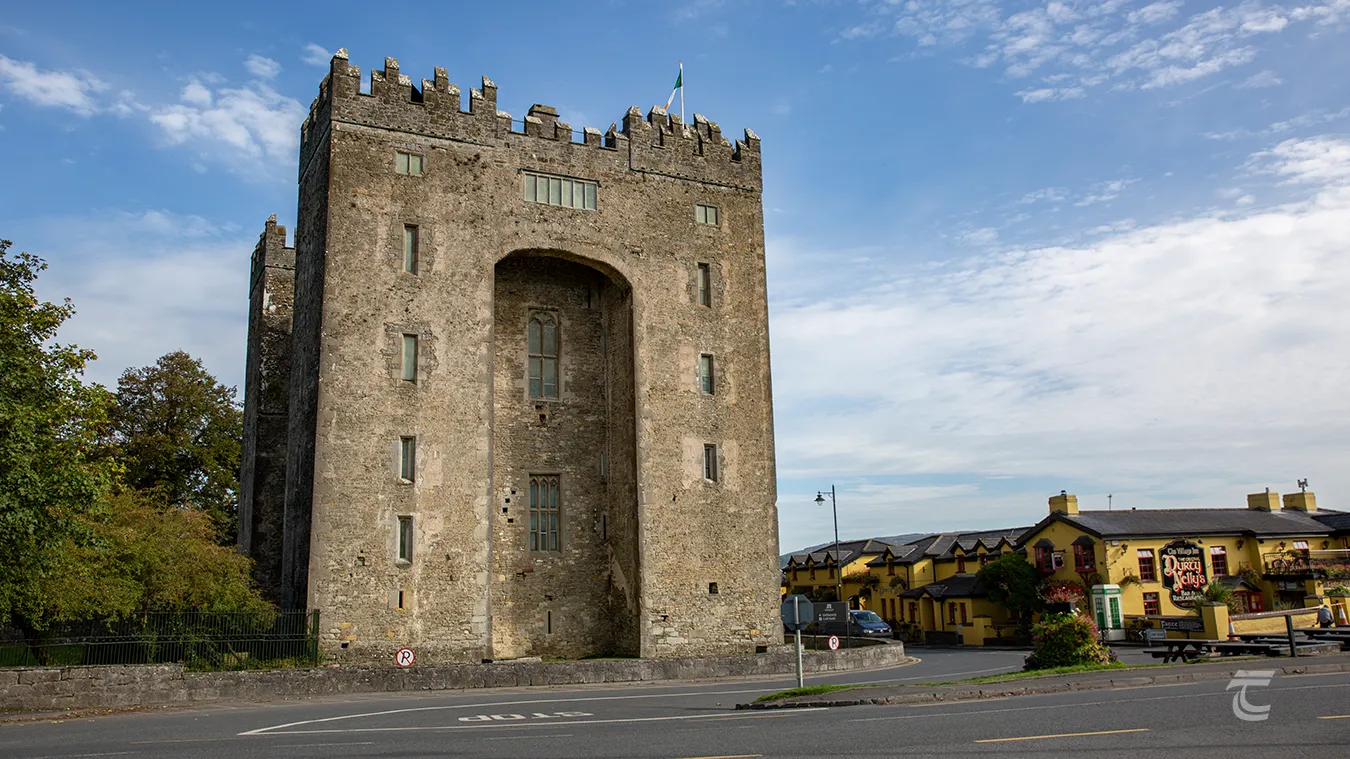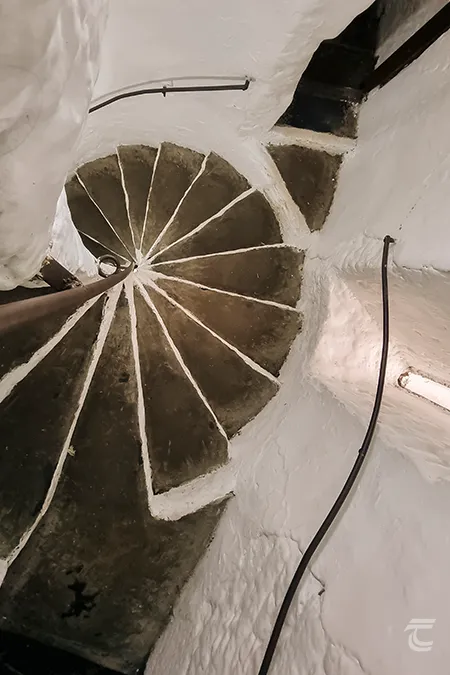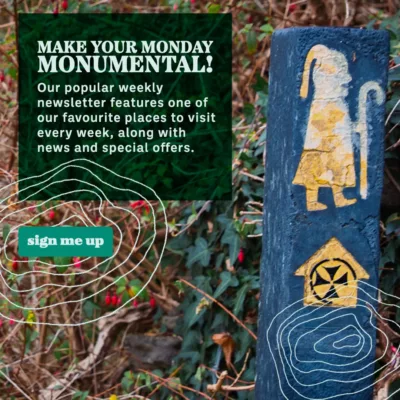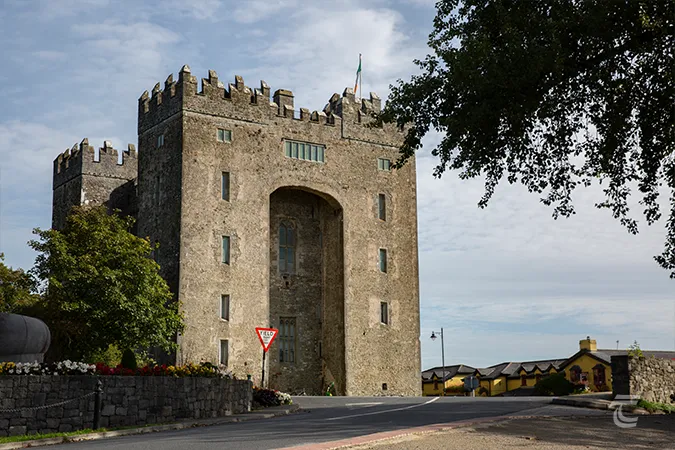Bunratty Castle & Folk Park
Bunratty Castle and Folk Park is undoubtedly one of the most visited heritage sites in Ireland. Though today it is mostly considered as a key tourism site, the castle has been a focal point for the community for centuries. Indeed the settlement at Bunratty initially developed around the castle and the nearby medieval church on the western banks of the Owenogarney (also known as Ratty) River. There have been at least four versions of Bunratty Castle. The original fortification at Bunratty is believed to have begun in the 13th century, when the Anglo-Norman Robert de Muscegros established an earth and timber fort. This may have been either a motte and bailey or a larger ringworks castle, however no visible evidence remains of this first phase at Bunratty. The first stone castle was established in around 1277, when Thomas de Clare had possession of the lands. The castle was attacked a number of times by the Irish, before it was finally captured and burned in 1306, and then finally destroyed in 1332. The 14th century was a particularly violent and turbulent era in Irish history, and by 1353, Thomas de Rokeby had repaired and refortified the castle only for it to be destroyed again shortly afterwards. Though there are elements of the third castle still visible, it is the fourth version of Bunratty Castle that is the one that is most visible to us today. This was constructed in the 15th century by Maccon MacNamara as an elegant towerhouse.
Bunratty Castle became a possession of the powerful O’Brien dynasty by the turn of the 16th century. In the years between 1583 and 1588, Donough O’Brien, made Bunratty his headquarters and carried out a number of alterations and embellished the castle with redbrick and elaborate plasterwork to make it more like a Tudor manor. Donough O’Brien was the Earl of Thomond, and had been brought up as a protestant at the court of Queen Elizabeth I. He remained a loyal subject and committed protestant throughout his life. During the bloody Nine Years War, Donough O’Brien supported the side of the English and their Dublin administration, and his lands became a target for raids by the Irish lords. He was part of the English victory over the Irish and Spanish at Kinsale in 1601. One of his lasting legacies, is that it was due to the request of Donough O’Brien that County Clare was removed from the province of Connacht and incorporated within Munster instead.
For practical information about visiting this site Click Here

Bunratty Castle • Clare
The Later History of Bunratty Castle
If the 14th century was a time of violence and despair in Ireland, the 17th century must have felt apocalyptic at times. The Irish Confederacy Wars that began with a great rebellion in Ulster in 1641 had spread throughout the country. The Irish Confederates consisted of powerful Catholic aristocrats, clergy and military leaders who wanted an end to anti-Catholic discrimination and larger self-governance for Ireland. This was at a deeply unsettled time that became known as the Wars of the Three Kingdoms, that encompassed Ireland, Scotland and England. At its heart it was a sectarian conflict and a power struggle, that included the English Civil War and the execution of King Charles I of England.
Barnaby Uí Briain, the 6th Earl of Thomond, was resident at Bunratty Castle at the beginning of this conflict. At the time the castle was described by Papal Nuncio Rinucinni as:
‘the loveliest of any place of any kind that I have yet seen (in Ireland), worthy of a king, with gardens the likes of which put Italy’s to shame.’
Barnaby had continued the family policy of loyalty to the English crown and parliament. His lands were planted with English and Dutch protestant tenants. However he tried to remain broadly neutral when the Confederacy Wars began, and as many of his O’Brien relatives had enthusiastically joined the rebellion, Bunratty was left alone to begin with. However by 1646, his cousin Murrough O’Brien (the feared Lord Inchiquin who carried out the massacre on the Rock of Cashel), encouraged Barnaby to surrender Bunratty Castle to English parliamentary forces. The Confederates sent a large force to lay siege, and captured Bunratty on the 13th July 1646.

One of the spiral staircases • Bunratty Castle

One of the spiral staircases • Bunratty Castle
Bunratty Castle took on a new aspect in the 18th century. By 1725 the Studdert family had possession, and left their mark by building a multi-storey house that adjoins the northern face of the castle. They also added a police station onto the western side of the tower. The castle was utilised as a RIC Barracks in the 19th century, leading to it being burned by the IRA during the War of Independence.
Since the 19th century there had been attempts to conserve and repair the historic building, before it was finally given to the care of the Board of Public Works in 1915. In 1954 the castle was purchased by Lord Gort, and with the advice of John Hunt and the Board of Works architect Percy Le Clerc, he set about restoring the castle, with the expenses divided between Gort, Bord Fáilte and the Board of Works. Lord Gort wanted to restore the medieval aspect of the castle, and he had the Studdert home and the police barracks demolished and removed, while adding fireplaces and furniture to give it a more medieval feel. The castle has been a visitor attraction since 1960, and today it is one of our most visited sites.
Despite some of the later alterations, it is still possible to get a feel for what it may have been like during its medieval heyday. There are many features to discover as you tour around the castle, with spiral stairs, garderobes (medieval toilets), fine windows and traces of the plasterwork added by Barnaby O’Brien. One of Bunratty Castles most interesting features is the sheela-na-gig. Due to its relatively small size she is quite easy to miss, but you will find her in the great hall in the recess for the south window. It was moved here during the restoration works in the 1950s, from its original position from a window in the top room of the south-western tower.
Bunratty Castle Folk Park (which was developed with the help of Kevin Danaher from the Irish Folklore Commission) was opened by President Erskine Childers in 1964. Initially it consisted of two small farmhouses, a fisherman’s hut, and a forge, but over the years more buildings have been added, including MacNamara’s Pub, Ardcroney Church, and Hazelbrook House. There are now 30 buildings, offering an immersive experience into Ireland’s past.
The Folklore of Bunratty Castle

The sheela na gig • Bunratty Castle
There are a number of stories relating to Bunratty Castle in the School’s Folklore Collection. Some of the stories say that the castle is haunted by the spirit of Julianna de Clare, and claim that it was she who persuaded her husband to murder Brian Rua O’Brien, King of Thomond. Though sceptics be warned! Another tale in the collection describes the fate of a man who did not believe that the castle was haunted. To prove it was all nonsense, he went into the castle at night. As he went from room, he noticed that he was followed by two Norman knights. He fled to the top of the tower, but the knights followed him. As they surged forwards to attack, he leapt over the battlements to escape, only to fall to his death.
My favourite tale of Bunratty Castle also features a ghostly knight:
‘There is a haunted field near the castle and when night falls no one would cross it. A Norman Knight with sword in hand walks the field and death awaits the intruder. A drunkard who had spent all his money, decided one night in a fit of despair to enter the field, and so end his life. He did so, and the “Norman” approached. Our friend showed no signs of fear, whereupon the ghost told him that he was the only man who had ever come into the field unafraid. The stranger then led him to a corner where there was hidden gold, and the drunkard was afterwards a rich and happy man’.
School’s Folklore Collection, Volume 0599, Page 330.

The sheela na gig • Bunratty Castle
Upper left: Bunratty Castle • Lower left: one of the castle bedrooms • Right: A street in Bunratty Castle Folk Park
Top: Bunratty Castle • Middle: A street in Bunratty Castle Folk Park • Bottom: one of the bedrooms in the castle
Bunratty Castle and Folk Park Visitor Information
One of the most-visited heritage sites in Ireland, Bunratty Castle and Folk Park offer an immersive plunge into Ireland’s past.



